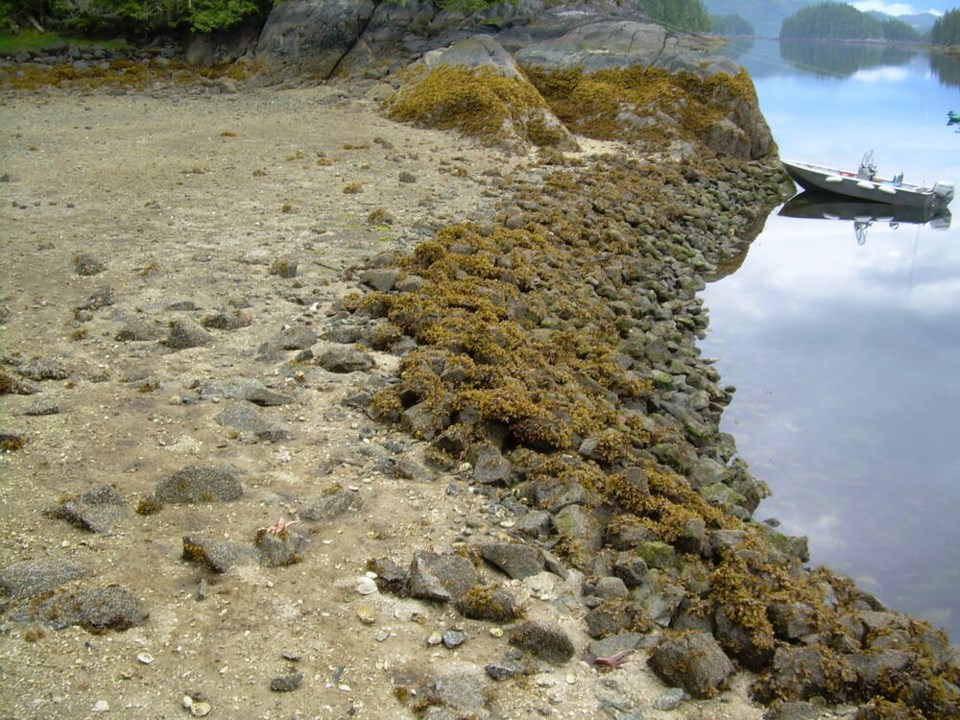Such gardens are part of a sophisticated system of traditional ecological and food management among First Nations from Alaska to Washington state

The clam garden being built in Coles Bay, off the west side of the Saanich Peninsula, represents a form of traditional aquaculture and technology that has been used on North America’s northwest coast for thousands of years.
In late May, the Pauquachin First Nation hired excavators to build a temporary land bridge out to a rock outcrop in the bay and to heap rock and gravel on the outcrop.
About 20 workers, some wearing outfits with the nation’s logo, also spread finely ground sea shells over the bay’s mudflats. The shells are used in some aquaculture operations to promote growth of clams and other molluscs.
The work has triggered an investigation by fisheries officials into whether habitat was destroyed and if authorization should have been required.
Shellfish harvesting in Coles Bay was prohibited in 1997 on health grounds because of pollution from septic systems. The Pauquachin First Nation announced its intention last summer to build a traditional clam garden in the bay.
The Coles Bay clam garden is part of a recent movement among coastal First Nations to regain, reintroduce and restore their traditional aquaculture practices in the region.
In 2014, members of the Cowichan Nation Alliance and WSÁNEĆ Nations, in partnership with Parks Canada and universities, began restoring two sea gardens in Gulf Islands National Park Reserve.
In 2022, members of the Swinomish Tribal Community built a clam garden on Kiket Island, in western Washington state.
Last year, the We Wai Kai, Wei Wai Kum, and K’ómoks First Nations started restoring some of the old Quadra Island clam gardens, while Tla-o-qui-aht youth have been tending a sea garden built in 2023 on Meares Island.
Such gardens are part of a sophisticated system of traditional ecological and food management among First Nations from Alaska to Washington state. Built in the intertidal zone, the sites have long allowed coastal Indigenous peoples to enhance local shellfish productivity and feed their people without exhausting local shellfish populations.
A clam garden typically features a rock wall built parallel to a beach’s low tide line and a flattened terrace on the wall’s landward side. The wall traps sediment, flattening the slope of the shore with each incoming tide and passing storm.
The resulting extension of intertidal beach provides a semi-protected place for clams to spawn and grow that is easier to manage than wild beaches.
Traditional shellfish farmers tend the garden by raking the sand and removing sea stars, sea urchins and other predators, as well as seaweed and dead clams. As with vegetable gardens, the marine farmers also thin the growing clams and preferentially harvest larger ones to allow younger clams to continue growing.
Studies have shown that a clam garden can produce two to four times more shellfish than a natural beach does. The clams farmed there can also grow larger than and almost twice as quickly as non-gardened clams do.
But because clam gardens are made mostly of rock and sediment and often have been built, added to, and adjusted over many years, they can be difficult to age.
This difficulty contributed to long-held colonial misconceptions — that First Nations peoples were hunters and foragers and lacked established agricultural practices or technologies.
In 2019, researchers from the Hakai Institute, Simon Fraser University, University of Fraser Valley and the Wei Wai Kum First Nation near Campbell River found a way to reliably estimate the age of a clam garden.
By radiocarbon dating invertebrates buried in or beneath the walls and beneath the terraces of nine clam gardens on Quadra Island, the archaeologists determined that some of the gardens have been in use for 3,500 years — ages corroborated by local sea level change data and dates from other marine-management features in the region.
The discovery pushes back the known history of clam gardens by about 2,000 years.
It confirms scientifically what many First Nations elders have been saying for years — coastal First Nations were building and tending clam gardens when slaves were building the pharoahs’ pyramids in Egypt.
[email protected]